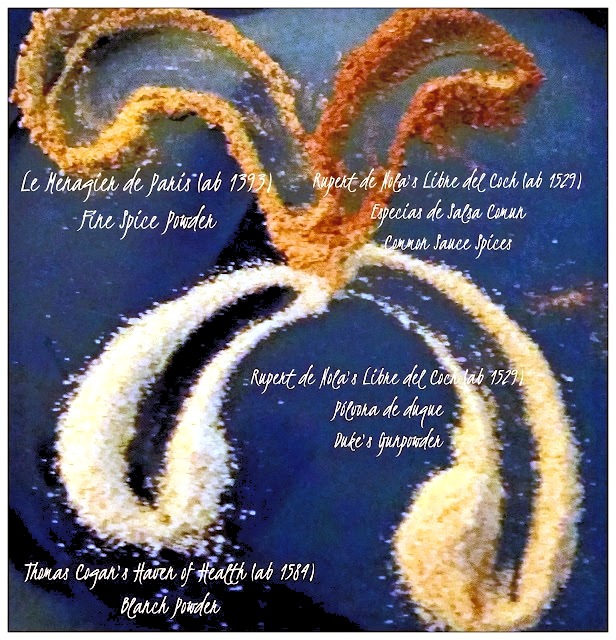Medieval Spice Powders: Douce, Forte, and More
Originally published: November 10, 2015 — Updated: August 19, 2025 (cleaned up formatting, added headings, and clarified measurements).
Oftentimes when you’re recreating a period recipe, you’re met with ambiguous terms for flavoring. When I originally posted this, I focused on two commonly referenced powders—Powder Douce (sweet powder) and Powder Forte (strong powder). As I run across other receipts, I add them here. This is a working notebook, not a decree—and I’ll say when something is my interpretation.

📖 Jump to a Section
- Powder Douce (Sweet Powder)
- Powder Forte (Strong Powder)
- Fine Powder of Spices (Le Menagier de Paris, c. 1393)
- Common Sauce Spices, Amended (Libre del Coch, 1529)
- The Duke’s Powder, Amended (Libre del Coch)
- Blaunch Poudere (The Haven of Health)
Need spoon-to-ounce conversions? See the Spice Measurement FAQ.
Powder Douce (Sweet Powder)
My working theory: Powder Douce wasn’t a single fixed formula but a family of mixes that leaned sweet, with sugar as the largest proportion, followed by cinnamon or ginger depending on what the cook had. That’s my belief, not gospel—please don’t quote it as settled fact.
My House Blend (3 : 2 : 1 : ½ idea)
- 1 tbsp sugar (refined white is fine; organic if you prefer)
- 1 ½ tsp ginger
- 1 ½ tsp cinnamon
- 1 tsp nutmeg
- 1 tsp mace
- ½ tsp cloves
- ½ tsp peppercorns
Sometimes I get cheeky and add a pinch of coriander.
Powder Forte (Strong Powder)
Powder Forte differs from Douce in that it’s pepper-forward. The version I use takes its cue from Robert May’s The Accomplisht Cook (1684) in the Bolonia Sausages recipe.
…then add to it three ounces of whole pepper, two ounces of pepper more grosly cracked or beaten, whole cloves an ounce, nutmegs an ounce finely beaten, salt, spanish, or peter-salt, an ounce, coriander-seed finely beaten, or carraway-seed, cinamon an ounce fine beaten…
Note: a dry ounce is approximately 2 tablespoons. That original yields a lot of Powder Forte; I use a smaller everyday batch below.
My Everyday Forte
- 1 tbsp black peppercorns or a mix of peppercorns, long pepper, cubebs, and grains of paradise
- 1 tsp each: clove, nutmeg, coriander, cinnamon
- Salt to taste
Both Douce and Forte are versatile, appear frequently in period cookery, and pull their weight in modern kitchens too.
Fine Powder of Spices (Le Menagier de Paris, c. 1393)
A set of instructions from Le Menagier de Paris for a “fine powder”:
FINE POWDER of spices. Take an ounce and a drachma of white ginger, a quarter-ounce of hand-picked cinnamon, half a quarter-ounce each of grains and cloves, and a quarter-ounce of rock sugar, and grind to powder.
Interpreted Recipe
- White ginger: 1 ounce + 1 drachma ≈ 10 drams ≈ ~2 ½ tbsp (~7 ½ tsp)
- Cinnamon (hand-picked): ~1 ½ tsp
- Grains of paradise: ~¾ tsp
- Cloves: ~¾ tsp
- Rock sugar: ~1 ½ tsp
Common Sauce Spices, Amended (Libre del Coch, 1529)
Rupert de Nola’s Libre del Coch gives this note for “common sauce spices, amended” (roughly translated):
Cinnamon three parts; cloves two parts; one piece ginger; pepper a part; some dry coriander well ground; a little saffron; be all well ground and sifted.
Interpreted Recipe
- 1 tbsp cinnamon
- 2 tsp cloves
- 1 tsp ginger
- 1 tsp pepper
- ½ tsp dry coriander (ground)
- Pinch of saffron
The Duke’s Powder, Amended (Libre del Coch)
Another powder from Libre del Coch (translated/modernized):
Cinnamon half an ounce, cloves half a quarter; and for the lords, do not lie down but only cinnamon; and sugar a pound if you want it sharp of flavor; and for passions of the stomach add a little ginger.
Interpreted Recipe
- Cinnamon, ½ ounce ≈ 1 tbsp
- Cloves, ⅛ ounce ≈ ¾ tsp
- Sugar, 1 pound (apothecaries’ 12-oz pound) ≈ ~1 ½ cups
- Ginger — “a little” ≈ ~1 tbsp
Mix and use as needed.
Note: A dry ounce ≈ 2 tbsp (≈ 1/8 cup).
Blaunch Poudere (The Haven of Health)
My search for the elusive “blaunch poudere” landed on The Haven of Health by Thomas Cogan/Coghan (first ed. late 16th c.; a 1636 printing survives). In “CHAP: 126. Of Ginger” we find:
Ginger is hot in the second degree, and dry in the first… also with two ounces of sugar, a quarter of an ounce of ginger, & half a quarter of an ounce of Cinnamon, all beaten small into powder, you may make a very good blanch powder, to strow upon rosted apples, Quinces, or Wardens, or to sauce a hen. … green ginger or ginger condite… comforteth much the stomacke and head…
Interpreted Recipe
- Sugar, 2 ounces ≈ 4 tbsp
- Ginger, ¼ ounce ≈ ~1 ½ tsp
- Cinnamon, ⅛ ounce ≈ ~¾ tsp
This makes a very pale, sandy powder—just a shade lighter than the pólvora de duque/Duke’s Powder. If you use a light cassia, it reads even paler. Because Cogan calls it a “very good blanch powder,” I suspect this is the “white” powder referenced in Harleian MS 279.
Working on substitutions for these spices? Visit the Spice Substitution Chart for historically sensible swaps.
📜 Sources & Notes
- Le Menagier de Paris (c. 1393) — “Fine Powder of Spices.”
- Rupert de Nola, Libre del Coch (1529) — “Common Sauce Spices,” “Duke’s Powder.”
- Robert May, The Accomplisht Cook (1684) — Bolonia Sausages (spice proportions that inform Forte).
- Thomas Cogan/Coghan, The Haven of Health (late 16th c.; 1636 ed.) — “Of Ginger” (blanch powder).
Translations here are working translations; any mistakes are mine. As always, adjust to taste and availability.
